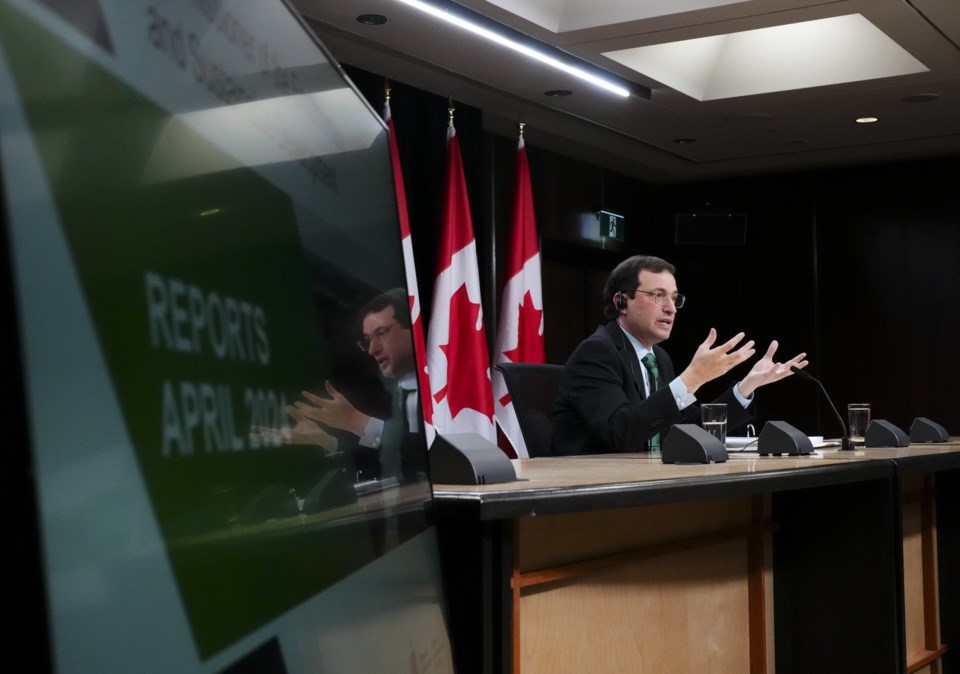OTTAWA — Ottawa’s efforts to prepare the country for the impacts of climate change have stumbled out of the gate, Canada’s environment commissioner said Tuesday.
In a new report, Jerry DeMarco concluded the National Adaptation Strategy was not effectively designed, did not prioritize Canada’s climate change risks and only established one of its three components since its release in 2023.
Canada has committed $1.6 billion to implementing the strategy, which is meant as a road map for communities across the country to up their game to prevent significant damage as the number of major storms, floods and fires increase exponentially with climate change.
Environment and Climate Change Canada estimated that every dollar spent on proactive adaptation measures can save taxpayers between $13 and $15 in the long term.
Canada was relatively late to the game when it released its strategy in 2023. Japan, France and the United Kingdom were already on the third updates of their plans at that point; Germany had updated its plan four times.
“We first recommended the development of a strategy to adapt to Canada’s changing climate nearly 20 years ago,” DeMarco said in a news release.
“Although the release of the National Adaptation Strategy in 2023 was an important first step, urgent attention is still needed to achieve impactful action. The sooner that Canada acts, the more sustainable the outcomes for people’s health, safety and livelihoods.”
DeMarco said the strategy failed to prioritize Canada’s climate change risks when establishing objectives and targets. He said government departments relied instead on existing priorities and consultations.
"We also found that although some climate change risks were identified during the consultation process for the strategy, they were not addressed in the final targets," the report said.
DeMarco cited the short-term health impacts of wildfire smoke, estimated to cost between $410 million and $1.8 billion annually between 2013 and 2018. He also remarked on the prevalence of Lyme disease cases, rising from 144 in 2009 to 2,525 in 2022 — an increase of more than 1,500 per cent.
“Environment and Climate Change Canada told us that it will not add any new targets until 2030. Without any dedicated targets to address these risks within the National Adaptation Strategy, the federal government had failed to highlight the need for immediate whole‑of‑society action to address them,” the report said.
Environment and Climate Change Canada also didn't develop "a process to keep climate change risks up to date and integrate them into future updates of the strategy," the report said.
DeMarco said federal programs meant to advance implementation of the National Adaptation Strategy contributed little.
Ottawa must report annually on 17 programs that are key to advancing the strategy’s implementation. DeMarco examined seven of them that account for $1.1 billion of the money earmarked for the strategy.
While several of them had goals and targets, DeMarco said there was nothing to show whether it was actually helping to advance the implementation of the National Adaptation Strategy.
"That's a big problem in terms of accountability for what are going to be very large expenditures, and already have been large expenditures to date, if you aren't tying them together," DeMarco told The Canadian Press.
"It's very difficult to know whether Canadians are getting value for the money that's being spent on it."
For instance, the government has allocated $164 million to a flood hazard identification and mapping program led by Natural Resources Canada — almost $40 million for the first year alone.
The report found the project had "minimal early actions taken" to determine whether it was actually contributing to the implementation of the national strategy.
"It is fairly unusual to have a strategy that doesn't have connected goals targets and indicators," Kim Leach, the audit's principal, told The Canadian Press.
"There's a lack of connection between the (national strategy) itself and some of these targets and indicators, because it's such a grab bag of old and new programming."
DeMarco also found the government has not yet finalized two of the three key pillars of the strategy.
He pointed out that an Indigenous climate leadership agenda still hasn't been established — it was supposed to be done by the end of 2024 — and the completion of federal, provincial and territorial bilateral action plans has been pushed to 2026. Only the federal government’s adaptation action plan has been finalized.
“Additionally, although First Nations, Inuit, and Métis organizations had each released national climate strategies, we found that Environment and Climate Change Canada had not formally assessed the coherence between federal programming and Indigenous-led strategies,” the report said.
This report by The Canadian Press was first published June 10, 2025.
Nick Murray, The Canadian Press



